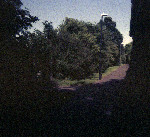The Pentax P30 is my first post about a series of automatic cameras. It has many automatic features but can still be overridden manually, is it the best of both worlds?
Why would you want an automatic camera?
With an automatic camera – assuming it’s working correctly – there’s less likely to go wrong, so user error is less of a problem. You don’t have to use a light meter to calculate the shutter speed and exposure, the camera does it for you. That enables you to take pictures more quickly and with more confidence that the exposure will be correct.
Why wouldn’t you want an automatic camera?
Pentax P30
Camera: £1.04
Postage: £3.75
Lenses: £5-10
Total: £10-15
full specs
It’s also more a question of chance when you’re buying a second-hand model as to whether you get a good one. With a manual camera it’s pretty easy to check whether the shutter fires at about the right speed and the aperture opens and closes. With an automatic, they are mostly untested as very often the sellers don’t know how to test them out.
Semi-automatic
With the Pentax P30 you still have to focus yourself, but the aperture and shutter speed can be controlled automatically. Both can also be altered manually and it tells you the recommended shutter speed to use inside the viewfinder. You are free to ignore the recommendation but you are unlikely to get a good picture if you stray too far from what it is telling you.
Many lenses
The lens fitting for Pentax cameras, called the K mount has been around for a long time and you are able to fit a wide variety of lenses to cameras like this one. I was able to fit a completely manual one, one with automatic aperture and a completely automatic autofocus lens – although the autofocus function is not supported by the P30 camera.
When focussing, there is a guide inside the viewfinder showing a sharp area of two semicircles in which the two halves line up horizontally when you are in focus. This method seems to work even if your vision is not perfect – usually if you wear glasses you need to keep them on when focussing a camera through the lens. I mention this because if you’re like me you have to take your glasses off to read the dials and controls close-up on the camera.
Film speed now matters more
With automatic cameras it is crucial that they know what film speed you are are using, as it changes which aperture and shutter speed need to be used, the same way you tell a light meter. Some cameras have a manual setting, but the Pentax P30 can automatically detect the speed using the DX code of silver and black squares present on newer film cartridges.
It can detect films from speeds between 25 and 1600 ISO in stops of 1, which means it covers most of the normal films speeds like 100, 200 and 400, but excludes very fast speeds as well as some of the in-between 1/3rd-stop speeds such as 125. If the film doesn’t have a DX code on it just assumes it’s 100, which could be very wrong.
So automatic isn’t always good?
As an electronic device it means the mechanical shutter and clockwork self-timer are now gone, replaced by electronic versions, so it needs batteries in to function at all. An unfortunate casualty of the move to electronics is the shutter release cable connector. Also the flash socket is now a hot shoe controlled through the foot, which requires a different type of flash unit.
The camera does have a bulb mode, but you have to hold the button down to operate it, which might lead to camera shake. I admit I rarely use long shutter times – they are often used to produce images in the dark of traffic where the lights draw lines – but it’s a nice feature to have if you need it.
The pics are here
Fuji Super HG 1600
Cost: £1.00
Postage: £3.00
Expired: October 1998
ISO: 1600
Format/Type: Colour Negative
Exposures: 36
Processing: £2.99
Full Total: £7.79
Cost per shot: £0.22
My Rating: 4
I expected fairly grainy pics owing to the high speed, but I had to do a lot of contrast and colour correction just to get anything half decent – most of the pics were underexposed, which I really was not expecting from very fast film.
I don’t think the Pentax P30 is necessarily a bad camera, but it produced pretty bad results. The age of the film was a factor, but it also seemed to have trouble coping with the speed, managing to underexpose one of the fastest films available.
I did enjoy using the camera though – it was nice to have it give me feedback instead of having to use a light meter, I’m a little disappointed that the pictures didn’t come out very well. I have quite a few other cameras to try out, so it will be a while before I come back to this one, but I will definitely give it another chance with some decent film.






















